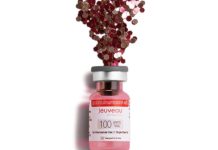Facial hair grafting is becoming an increasingly popular procedure with methods such as follicular unit extraction (FUE) and follicular unit transplantation (FUT) to improve the hair appearance of beards and eyebrows.
While scalp hair transplants are common in aesthetics, using hair transplant technology to improve facial hair outcomes is gaining increased popularity for patients who wish to improve beard and eyebrow fullness. In an interview with Aesthetic Authority®, Gary Linkov, MD, board-certified facial plastic and hair surgeon and founder and medical director of City Facial Plastics in New York, New York, gives an overview of beard and eyebrow grafting to improve patient facial hair appearance.
First, when patients are preparing for grafting, he says, they are directed to stop all oral supplements along with over-the-counter medications that can cause blood thinning.
“Vitamin C and Vitamin K a week before the facial hair transplant procedure can help improve healing and minimize bleeding,” he says.
Patients shower the night before or the morning of the procedure to prevent infection and are also prescribed an antibiotic, an anti-inflammatory pill, a sedative, and ananxiolytic the morning of the procedure, he explains. Following patient consent, the beard area or eyebrow area is marked carefully to incorporate the patient’s wishes.
Patients then undergo follicular unit extraction (FUE), which takes hair strands with the follicles attached from one body site and then transplants them to the desired area. Another method of transplanting hair is follicular unit transplantation (FUT), which excises a strip of skin with hair follicles to be used.
“Once the grafts are removed, recipient site creation and then placement of the grafts occurs,” Linkov says. “The overall process may take a few hours for smaller cases, up to a full day for larger cases, and occasionally may require an extra day. A lunch break is provided for longer cases.”
Explaining the procedure downtime, he says bleeding, swelling, and bruising are all possible after a facial hair transplant. “The most important precaution in the recovery phase of a beard transplant is to not get the transplanted hairs wet for the first 5 days. This allows them to set in the proper orientation and to eventually grow,” he emphasizes.
Post-procedure, patients are also given both an oral and topical antibiotic for the donor area, he says.
For beard transplants, patients are able to shave after 10 days, he says. Linkov explains that after about 3 weeks the shafts of the transplanted hairs will usually fall out. Hair regrowth then starts at 4-6 months, with patients having final results assessed at 1 year.
There are some associated risks with the procedure; one of which is poor angulation.
“Despite every best effort to use an acute angle to the skin surface when making recipient sites and placing grafts, occasionally, grafts may still grow at a more perpendicular angle and may need to be removed,” he notes.
There is also the chance of bump formation. “The main area at risk of small bump formation is the goatee area under the lower lip,” Linkov says. “These can be difficult to correct.”
The risk of poor regrowth, while possible, is rare, according to Linkov. “The face has very good blood supply and typically results in excellent hair regrowth,” he says. “A touch-up procedure is sometimes needed after 10 months if certain areas show poor growth.”
Finally, inclusion cysts can occur but are very rare in the transplanted beard area and may need to be incised and drained or removed, he says.
Linkov explains that scar formation is another consideration. Small circular scars are left after using the FUE method, “but they are barely noticeable even with a shaved head,” he said. The FUT method, however, leaves a linear scar across the back of the head, which makes it more difficult to wear shorter hairstyles.
“The recipient area where the new beard hairs grow should not display any scars,” he explains.
Medical conditions not compatible with local anesthesia containing epinephrine would be contraindications to FUE and FUT facial hair transplantation.
“Contraindications to facial hair transplants is scarring alopecia’s or autoimmune alopecia areata, in which the body will continue to try and destroy the hair follicles,” he says, adding that having minimal hair supply for transplantation to the facial area is also a contraindication.
References:
1. NYC Beard Transplant/New York Beard Restoration/UES. City Facial Plastics. 2021. Accessed May 25, 2021. https://cityfacialplastics.com/beard-transplant/
2. NYC Eyebrow Restoration/New York Eyebrow Hair Transplant/UES. City Facial Plastics. 2021. Accessed May 25, 2021. https://cityfacialplastics.com/eyebrow-transplant/






